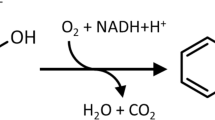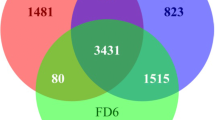Abstract
An Arthrobacter strain, able to utilize 4-chlorobenzoic acid as the sole carbon and energy source, was isolated and characterized. The first step of the catabolic pathway was found to proceed via a hydrolytic dehalogenation that leads to the formation of 4-hydroxybenzoic acid. The dehalogenase encoding genes (fcb) were sequenced and found highly homologous to and organized as those of other 4-chlorobenzoic acid degrading Arthrobacter strains. The fcb genes were cloned and successfully expressed in the heterologous host Pseudomonas putida PaW340 and P. putida KT2442 upper TOL, which acquired the ability to grow on 4-chlorobenzoic acid and 4-chlorotoluene, respectively. The cloned dehalogenase displayed a high specificity for para-substituted haloaromatics with affinity Cl > Br > I » F, in the order.



Similar content being viewed by others
References
Abril MA, Michan C, Timmis KN, Ramos JL (1989) Regulator and enzyme specificities of the TOL plasmid-encoded upper pathway for degradation of aromatic hydrocarbons and expansion of the substrate range of the pathway. J Bacteriol 171:6782–6790
Adriaens P, Kohler HP, Kohler-Staub D, Focht DD (1989) Bacterial dehalogenation of chlorobenzoates and coculture biodegradation of 4,4′-dichlorobiphenyl. Appl Environ Microbiol 55:887–892
Blatny JM, Brautaset T, HC Winther-Larsen, Haugan K, Valla S (1997) Construction and use of a versatile set of broad-host-range cloning and expression vectors based on the RK2 replicon. Appl Environ Microbiol 63:370–379
Brinkmann U, Reineke W (1992) Degradation of chlorotoluenes by in vivo constructed hybrid strains: problems of enzyme specificity, induction and prevention of meta-pathway. FEMS Microbiol Lett 75:81–87
Chae JC, Kim Y, Kim YC, Zylstra GJ, Kim CK (2000) Genetic structure and functional implication of the fcb gene cluster for hydrolytic dechlorination of 4-chlorobenzoate from Pseudomonas sp. DJ-12. Gene 258:109–116
Chang KH, Liang PH, Beck W, Scholten JD, Dunaway-Mariano D (1992) Isolation and characterization of the three polypeptide components of 4-chlorobenzoate dehalogenase from Pseudomonas sp. strain CBS-3. Biochemistry 31:5605–5610
Chaudhry GR, Chapalamadugu S (1991) Biodegradation of halogenated organic compounds. Microbiol Rev 55:59–79
Deutscher MP (1990) Methods in enzymology. Guide to protein purification, vol 185. Academic, San Diego, CA, USA
Fetzner S, Lingens F (1994) Bacterial dehalogenases: biochemistry, genetics, and biotechnological applications. Microbiol Rev 58:641–685
Franklin FCH, Bagdasarian M, Bagdasarian MM, Timmis KN (1980) Molecular and functional analysis of the TOL plasmid pWWO from Pseudomonas putida and cloning of genes for entire regulated aromatic ring meta cleavage pathway. Proc Natl Acad Sci U S A 78:7458–7462
Freier RK (1974) Wasseranalyse, 2nd edn. Walter de Gruyter, Berlin, Germany
Gartemann KH, Eichenlaub R (2001) Isolation and characterization of IS1409, an insertion element of 4-chlorobenzoate-degrading Arthrobacter sp. strain TM1, and development of a system for transposon mutagenesis. J Bacteriol 183:3729–3736
Göbel M, Kranz OH, Kaschabek SR, Schmidt E, Pieper DH, Reineke W (2004) Microorganisms degrading chlorobenzene via a meta-cleavage pathway harbor highly similar chlorocatechol 2,3-dioxygenase-encoding gene clusters. Arch Microbiol 182:147–156
Häggblom MM (1992) Microbial breakdown of halogenated aromatic pesticides and related compounds. FEMS Microbiol Rev 103:29–72
Haigler BE, Spain JC (1989) Degradation of p-chlorotoluene by a mutant of Pseudomonas sp. strain JS6. Appl Environ Microbiol 55:372–379
Higgins D, Thompson J, Gibson T, Thompson JD, Higgins DG, Gibson TJ (1994) Clustal W: improving the sensitivity of progressive multiple sequence alignment through sequence weighting, position-specific gap penalties and weight matrix choice. Nucleic Acids Res 22:4673–4680
Holloway P, Trevors JT, Lee H (1998) A colorimetric assay for detecting haloalkane dehalogenase activity. J Microbiol Methods 32:31–36
Hopwood DA, Bibb MJ, Chater KF, Kieser T, Bruton CJ, Kieser HM, Lydiate CP, Smith CP, Ward JM, Schrempf H (1985) Genetic manipulation of Streptomyces—a laboratory manual. The John Innes Foundation, Norwich
Horowitz A, Suflita JM, Tiedje JM (1983) Reductive dehalogenations of halobenzoates by anaerobic lake sediment microorganisms. Appl Environ Microbiol 45:1459–1465
Hrywna Y, Tsoi TV, Maltseva OV, Quensen JF 3rd, Tiedje JM (1999) Construction and characterization of two recombinant bacteria that grow on ortho-and para-substituted chlorobiphenyls. Appl Environ Microbiol 65:2163–2169
Kaschabek SR, Kasberg T, Müller D, Mars AE, Janssen DB, Reineke W (1998) Degradation of chloroaromatics: purification and characterization of a novel type of chlorocatechol 2,3-dioxygenase of Pseudomonas putida GJ31. J Bacteriol 180:296–302
Klages U, Lingens F (1979) Degradation of 4-chlorobenzoic acid by a Nocardia sp. FEMS Microbiol Lett 6:201–203
Marks TS, Smith ARW, Quirk AV (1984) Degradation of 4-chlorobenzoic acid by Arthrobacter sp. Appl Environ Microbiol 48:1020–1025
Miller JH (1972) Experiments in molecular genetics. Cold Spring Harbor Laboratory, Cold Spring Harbor, NY
Müller R, Oltmanns RH, Lingens F (1988) Enzymatic dehalogenation of 4-chlorobenzoate by extracts from Arthrobacter sp. SU DSM 20407. Biol Chem Hoppe Seyler 369:567–571
Nikodem P, Hecht V, Schlomann M, Pieper DH (2003) New bacterial pathway for 4- and 5- chlorosalicylate degradation via 4-chlorocatechol and maleylacetate in Pseudomonas sp. strain MT1. J Bacteriol 185:6790–6800
Panke S, Sanchez-Romero JM, de Lorenzo V (1998) Engineering of quasi-natural Pseudomonas putida strains for toluene metabolism through an ortho-cleavage degradation pathway. Appl Environ Microbiol 64:748–751
Pieper DH, Reineke W (2000) Engineering bacteria for bioremediation. Curr Opin Biotechnol 11:262–270
Pollmann K, Beil S, Pieper DH (2001) Transformation of chlorinated benzenes and toluenes by Ralstonia sp. strain PS12 tecA (tetrachlorobenzene dioxygenase) and tecB (chlorobenzene dihydrodiol dehydrogenase) gene products. Appl Environ Microbiol 67:4057–4063
Reineke W, Knackmuss H-J (1980) Hybrid pathway for chlorobenzoate metabolism in Pseudomonas sp. B13 derivatives. J Bacteriol 142:467–473
Reineke W (1998) Development of hybrid strains for the mineralization of chloroaromatics by patchwork assembly. Annu Rev Microbiol 52:287–331
Sambrook J, Fritsch EF, Maniatis T (1989) Molecular cloning. A laboratory manual, 2nd edn. Cold Spring Harbour Laboratory Press, Cold Spring Harbour, New York
Schmitz A, Gartemann KH, Fiedler J, Grund E, Eichenlaub R (1992) Cloning and sequence analysis of genes for dehalogenation of 4-chlorobenzoate from Arthrobacter sp. strain SU. Appl Environ Microbiol 58:4068–4071
Thiele J, Müller R and Lingens F (1987) Initial characterization of 4-chlorobenzoate dehalogenase from Pseudomonas sp. CBS3. FEMS Microbiol Lett 41:115–119
Thoden JB, Zhuang Z, Dunaway-Mariano D, Holden HM (2003) The structure of 4-hydroxybenzoyl-CoA thioesterase from Arthrobacter sp. strain SU. J Biol Chem 278:43709–43716
Tsoi TV, Zaitsev GM, Plotnikova EG, Kosheleva IA, Boronin AM (1991) Cloning and expression of the Arthrobacter globiformis KZT1 fcbA gene encoding dehalogenase (4-chlorobenzoate-4-hydroxylase) in Escherichia coli. FEMS Microbiol Lett 65:165–169
van den Tweel WJ, Kok JB, de Bont JAM (1987) Reductive dechlorination of 2,4-dichlorobenzoate to 4-chlorobenzoate and hydrolytic dehalogenation of 4-chloro-, 4-bromo-, and 4-iodobenzoate by Alcaligenes denitrificans NTB-1. Appl Environ Microbiol 53:810–815
Vieira J, Messing J (1982) The pUC plasmid and M13mp7 derived system for insertion mutagenesis and sequencing with synthetic universal primers. Gene 19:259–268
Widmer F, Seidler RJ, Gillevet PM, Watrud LS, Di Giovanni GD (1998) A highly selective PCR protocol for detecting 16S rRNA genes of the genus Pseudomonas (sensu stricto) in environmental samples. Appl Environ Microbiol 64:2545–2553
Yanisch-Perron C, Vieira J, Messing J (1985) Improved M13 phage cloning vectors and host strains: nucleotide sequences of M13mp18 and pUC19 vectors. Gene 33:103–119
Zaitsev GM, Karasevich YN (1985) Primary steps in metabolism of 4-chlorobenzoate in Arthrobacter globiformis. Mikrobiologiya 50:423–428, in Russian
Zhuang Z, Gartemann KH, Eichenlaub R, Dunaway-Mariano D (2003) Characterization of the 4-hydroxybenzoyl-coenzyme A thioesterase from Arthrobacter sp. strain SU. Appl Environ Microbiol 69:2707–2711
Acknowledgments
This work was supported by the FIRB project n. RBAU015FL2 (MIUR, Rome) “Screening and characterization of ecofunctional genes and enzymes from high GC Gram-positive bacteria for ecological and bioremediation studies” of P.B. Part of this work was supported by a FEMS Short-term Fellowship given to F. Radice. F. Gorreta collaborated in the experimental work. We are also in debt with V. De Lorenzo, who kindly provided the P. putida KT2442 upper TOL strain, and with R. Eichenlaub, for providing pAS5.
Author information
Authors and Affiliations
Corresponding author
Rights and permissions
About this article
Cite this article
Radice, F., Orlandi, V., Massa, V. et al. Cloning of the Arthrobacter sp. FG1 dehalogenase genes and construction of hybrid pathways in Pseudomonas putida strains. Appl Microbiol Biotechnol 75, 1111–1118 (2007). https://doi.org/10.1007/s00253-007-0906-z
Received:
Revised:
Accepted:
Published:
Issue Date:
DOI: https://doi.org/10.1007/s00253-007-0906-z




